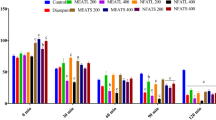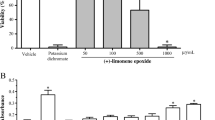Abstract
Safety of natural products is a priority before they are acceptable for consumption. Alstonia boonei De Wild (Apocynaceae) stem-bark and Picralima nitida (Stapf) T. & H. Dur. (Apocynaceae) seed are combined into a powder dosage form for the treatment of malaria fever. This study evaluated the central nervous system effects and the toxicity of the remedy on acute and repeated doses with a view to providing information on its safety. The powder mixture (ratio 1:2) of A. boonei stem-bark and P. nitida seed was extracted with water by the decoction method, concentrated in vacuo and freeze-dried. The acute toxicity of the extractive was determined by Lorke’s method. For the novelty-induced behaviour tests, 24 mice (18–22 g) of four groups (six mice per group) were orally given the aqueous solution of the extractive at 12.5, 25 and 50 mg/kg while the control group was given distilled water once daily for 30 days, after which the liver, kidney, brain, spleen and testes of each animal were humanely harvested for histopathological examination. At 25 mg/kg, a significant increase (P < 0.05) was observed in the grooming activity of the mice on acute and repeated doses. Histopathological analysis revealed that all the organs were essentially normal when compared with the control. The repeated oral administration of the extractive was relatively safe at each of the doses tested.







Similar content being viewed by others
References
Abel C, Busia K (2005) An exploratory ethnobotanical study of the practice of herbal medicine by the Akan peoples of Ghana. Altern Med Rev 10 (2):112-122
Adeniyi A, Asase A, Ekpe PK, Asitoakor BK, Adu-Gyamfi A, Avekor PY (2018) Ethnobotanical study of medicinal plants from Ghana; confirmation of ethnobotanical uses, and review of biological and toxicological studies on medicinal plants used in Apra Hills Sacred Grove. J Herb Med 14:76–87
Adeoluwa OA, Aderibigbe AO, Agu GO (2016) Pharmacological evaluation of central nervous system effects of ethanol leaf extract of Olax subscorpioidea in experimental animals. Drug Res 66(4):203–210
Adjei GO, Goka BQ, Rodrigues OP, Høgberg LCG, Alifrangis M, Kurtzhals JAL (2009) Amodiaquine-associated adverse effects after inadvertent overdose and after a standard therapeutic dose. Ghana Med J 43(3)
Ajayi AA, Ukponmwan OE (1994) Possible evidence of angiotensin II and endogenous opioid modulation of novelty-induced rearing in the rat. Afr J Med Sci 22:287–290
Ajayi CO, Elujoba AA, Adepiti AO (2015) Antiplasmodial properties of Alstonia boonei stem-bark and Picralima nitida seed in different combinations. Nig J Nat Prod Med 19:71–77
Akanmu MA, Olowookere TA, Atunwa SA, Ibrahim BO, Lamidi OF, Adams PA, Ajimuda BO, Adeyemo LE (2011) Neuropharmacological Effects of Nigerian Honey in Mice. Afr J Tradit Complement Altern Med 8(3):230–249
Asuzu IU, Anaga AO (1991) Pharmacological screening of the aqueous extract of Alstonia boonei stem-bark. Fitoterapia. 63:411–417
Barros HM, Tannhauser SL, Tannhauser MA, Tannhauser M (1994) The effects of GABAergic drugs on grooming behaviour in the open field. Pharmacol Toxicol 74:339–344
Betti JL (2004) An ethnobotanical study of medicinal plants among the Baka Pygmies in the Dja biosphere reserve, Cameroon. African Study Monographs 25(1):1–27
Carleton HM, Drury RAB, Wallington EA (1980) Carleton’s histological technique, 5th edn. Oxford University Press, UK. 41, pp 57–67
Crusio WE (2001) Genetic dissection of mouse exploratory behaviour. Behav Brain Res 125:127–132
Danysz W, Parsons CG, Bresnik I, Quack G (1996) Glutamate in CNS disorders. Drug News Perspect 8:261–277
David KL, Fawehinmi HB, Amadi OI (2016) Responses to aqueous leaf extract of Luffa aegyptiaca Mill on mefloquine-induced seizure in rat using open field test. Nigerian J Neurosci 7(2):69–74
Donald IM, Oghale OU, Ikechi EG, Orji OA (2016) Hepatoprotective potentials of Picralima nitida against in vivo carbon tetrachloride-mediated hepatotoxicity. J Phytopharmacol 5:6–9
Duwiejua M, Woode E, Obiri DD (2002) Pseudo-akuammigine, an alkaloid from Picralima nitida seeds, has anti-inflammatory and analgesic actions in rats. J Ethnopharmacol 81:73–79
Falodun AT, Ajayi CO, Obuotor EM, Adepiti AO, Akanmu MA, Elujoba AA (2015) Antiplasmodial Properties, Toxicity and novelty-induced behaviour of a formulation from Picralima nitida and Alstonia boonei. Eur J Med Plant 8(2):112–120
Hudson A, Lopez E, Almalki AJ, Roe AL, Calderón AI (2018) A review of the toxicity of compounds found in herbal dietary supplements. Planta Med 84(09/10):613–626
Inya-Agha SI (1999) The hypoglycaemic properties of Picralima nitida. Nig J Nat Pro Med 3:66–67
Iwu MM (2014) Handbook of African medicinal plants, 2nd edn. CRC Press, Boca Raton, pp 277–279
Iwu MM, Klayman DL (1992) Evaluation of the in vitro antimalarial activity of Picralima nitida extracts. J Ethnopharmacol 36(2):133–135
Iwu MM, Jackson JE, Tally JD, Klayman DL (1992) Evaluation of plants extract for antileishmanial activity using a mechanism based radiorespirometric microtechnique (RAM). Planta Med 58:436–441
Iyiola OA, Tijani AY, Lateef KM (2011) Antimalarial activity of ethanolic stem-bark extract of Alstonia boonei in mice. Asian J Biol Sci 4:235–243
Kalueff A, LaPorte JL, Bergner C (2010) Neurobiology of grooming behavior. Cambridge Univ. Press, UK
Komorowska J, Pellis SM (2004) Regulatory mechanism underlying novelty-induced grooming in laboratory rats. Behav Process 67:287–293
Kouitcheu ML, Penlap BV, Kouam J, Ngadjui BT, Fomum ZT, Etoa FX (2006) Evaluation of antidiarrhoeal activity of the fruit-rind Picralima nitida (Apocynaceae). Afr J Trad Complement Altern Med 3:66–73
Lorke D (1983) A new approach to practical acute toxicity testing. Arch Toxicol 54:275–287
Mbegbu EC, Omoja VU, Ekere SO, Okoye CN, Uchendu CN (2014) Effects of ethanolic fruit extract of Picralima nitida (Stapf) on fertility of pregnant rats. Comp Clin Pathol 24(2):269–273
Nafiu MO, Akanji MA, Yakubu MT (2013) Toxicity of aqueous root extract of Cochlospermum planchonii (an anti-malarial herb) in selected tissues of mice. Comp Clin Pathol 22:1211–1218
Nkere CK, Iroegbu CU (2005) Antibacterial screening of the roots, seed and stem-bark extracts of Picralima nitida. Afr J Biotechnol 4:522–526
Nkono BL, Sokeng SD, Désiré DD, Frida L, Kamtchouing P (2015) Subchronic toxicity of aqueous extract of Alstonia boonei De wild. (Apocynaceae) stem bark in normal rats. Int J. Pharm. Pharmacol. 3(1):5–10
Ojewole JAO (1984) Studies on the pharmacology of Echitamine, an alkaloid form the stem-bark of Alstonia boonei (Apocynaceae). Int J Crude Drug Res 22:121–143
Ojo O, Ajiboye B, Akintayo CO (2014) Prophylactic effects of ethanolic extract of Alstonia boonei stem bark against DDVP-induced toxicity in Albino rats. J Pharm Biomed Sci 4(07):650–657
Okokon JE, Antia BS, Igboasoiyi AC, Essien EE, Mbagwua HOC (2007) Evaluation of antiplasmodial activity of ethanolic seed extract of Picralima nitida. J Ethnopharmacol 111:464–467
Okoye NN, Ajaghaku DL, Okeke HN, Iloigwe EE, Nworu CS, Okoye FB (2014) β-amyrin and α-amyrin acetate isolated from the stem-bark of Alstonia boonei display profound anti-inflammatory activity. Pharm Biol 52(11):1478–1486
Otoo LF, Koffuor GA, Ansah C, Mensah KB, Benneh C, Ben OI (2015) Assessment of an ethanolic seed extract of Picralima nitida ([Stapf] Th. And H. Durand) on reproductive hormones and its safety for use. J. Intercult Ethnopharmacol 4(4):293–301
Oze GO, Nwanjo HU, Onyeze GO (2007) Nephrotoxicity caused by the extract of Alstonia boonei (De Wild) stem-bark in guinea pigs. Internet J Nutr Wellness 3:25–29
Raji Y, Salman TM, Akinsomisoye OS (2005) Reproductive functions in male rats treated with methanolic extract of Alstonia boonei stem-bark. Afr J Biomed Res 8(2):105–111
Rang HP, Dale MM, Ritter JM, Moore PK (2003) Pharmacology. 5th Edn., Churchill Livingstone. Edinburgh. p. 352-366.
Sachs BD (1988) The development of grooming and its expression in adult animals. Ann N Y Acad Sci 525:1–17
Sofowora A (2008) Medicinal plants and traditional medicine in Africa, 3rd edn. Spectrum Books Limited, Ibadan, pp 199–204
Solomon IP, Ekandem GJ, Oyebadejo SA, Okon EA (2014) Chronic oral consumption of ethanolic extract of Picralima nitida (Akuamma) seed induced histopathological changes on the testes of adult wistar rats. Int J Pharm Res Allied Sci 3(4):71–77
Spruijt BM, van Hooff JA, Gispen WH (1992) Ethology and neurobiology of grooming behavior. Physiol Rev 72:825–852
Stoessl AJ, (1994) Dopamine D1 receptor agonist-induced grooming is blocked by the opioid receptor antagonist naloxone. Eur J. Pharmacol. 25:301–303
Suarez M, Perassi N, Dal Zotto S (1996) Adrenocortical response to open field test in rats with anterodorsal thalami nuclei lesion. Arch Physiol Biochem 104(1):81–86
Sunmonu TO, Oloyede OB, Owolarafe TA, Yakubu MT, Dosumu OO (2014) Toxicopathological evaluation of Picralima nitida seed aqueous extract in Wistar rats. Turkish J Biochem 39(2):119–125
Wosu LO, Ibe CC (1989) Use of extract Picralima nitida bark in the treatment of experimental trypanosomiasis: a preliminary study. J Ethnopharmacol 25:263–268
Wroblewski JT, Danysz W (1989) Modulation of Glutamate receptors: molecular mechanisms and functional implications. Annu Rev Pharmacol Toxicol 29:441–474
Author information
Authors and Affiliations
Corresponding author
Ethics declarations
Ethical approval
All applicable international, national and/or institutional guidelines for the care and use of animals were followed.
Conflicts of interest
All authors declared that they have no conflict of interest.
Additional information
Publisher’s note
Springer Nature remains neutral with regard to jurisdictional claims in published maps and institutional affiliations.
Rights and permissions
About this article
Cite this article
Ajayi, C.O., Elujoba, A.A., Adepiti, A.O. et al. Neurobehavioural and repeated-dose toxicity studies on the extractive from the decoction of a mixture of Alstonia boonei and Picralima nitida in mice. Comp Clin Pathol 29, 375–383 (2020). https://doi.org/10.1007/s00580-019-03058-y
Received:
Accepted:
Published:
Issue Date:
DOI: https://doi.org/10.1007/s00580-019-03058-y




